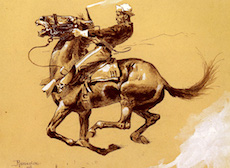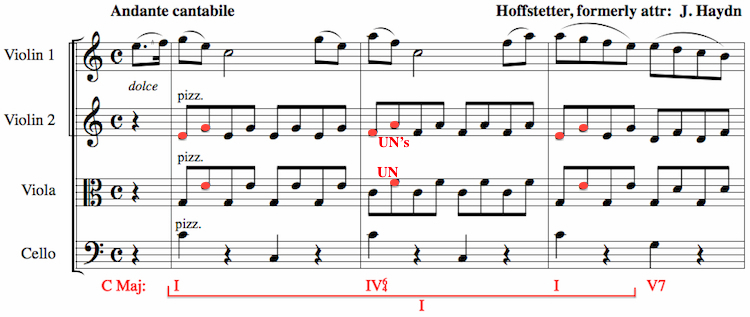
HARMONIC EXPANSIONS
CHAPTER 3: 6/4 LINEAR EXPANSIONS
3.6 The Neighbor (or Pedal) 6/4
 |
 |
 |
 A painting by the American artist Frederic Remington--not the kind of horseman Schumann had in mind!
A painting by the American artist Frederic Remington--not the kind of horseman Schumann had in mind!
|
In the above music from Schumann's "The Wild Horseman" (Album for the Young, Op.68), both linear and vertical interpretations are shown below the staff. Depending on the level of analysis the D and F, in red in measure 2, are either neighbor tones expanding a tonic triad that lasts two full measures (a linear interpretation represented by "NT's" and "i" below the bracket), or they are members of a brief iv6/4 triad on the third eighth note of measure 2 (a vertical interpretation represented by the "iv" above the bracket). Similarly in measure 3 the A and C, also in red, are either neighbor tones expanding a dominant triad (looking linearly), or they are members of a brief i6/4 on the third eighth note (looking vertically).
In either case the notes above the 6 and 4 are called a neighbor 6/4 after the nonharmonic tones. However these notes are also sometimes called a pedal 6/4. The reason for this second name is that the bass stays stationary while an upper voice moves from a consonant third to a dissonant fourth and back to a third. This motionless bass against an occasional dissonance is similar to the nonharmonic pedal tone (or pedal point).
|
In Examples 1 and 2 to the right, red notes above the 6's and 4's are labeled both as upper neighbors (UN)--expanding the tonic triads shown below the brackets--and as members of a triad--the IV chords shown above the brackets. In Example 3 the upper neighbors expand the dominant instead of the initial tonic, creating a brief second inversion tonic triad. Voices which do not move can either sustain their notes or repeat themselves. In the music to the right these pitches are usually sustained. However in measure 1 of Example 2 the soprano repeats its E-flat. |
In the following score of Hoffstetter's "Serenade" (in his String Quartet Op.3 in F) the notes of the neighbor, or pedal, 6/4 are within repeated patterns of notes called figurations. Notice the composer was careful to keep the neighbor tones in the figurations consistent from one chord to the next so that, in the second violin, the first note of second measure is the upper neighbor of the corresponding note (the first one) in the first measure. Similarly the second note of the second measure is the upper neighbor of the corresponding note (the second one) in the first measure.
 |
 |
 |
 |
 |
Comments? Click here. |



